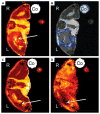In vivo MRI cell tracking using perfluorocarbon probes and fluorine-19 detection
- PMID: 23606473
- PMCID: PMC3893103
- DOI: 10.1002/nbm.2948
In vivo MRI cell tracking using perfluorocarbon probes and fluorine-19 detection
Abstract
This article presents a brief review of preclinical in vivo cell-tracking methods and applications using perfluorocarbon (PFC) probes and fluorine-19 ((19) F) MRI detection. Detection of the (19) F signal offers high cell specificity and quantification ability in spin density-weighted MR images. We discuss the compositions of matter, methods and applications of PFC-based cell tracking using ex vivo and in situ PFC labeling in preclinical studies of inflammation and cellular therapeutics. We also address the potential applicability of (19) F cell tracking to clinical trials.
Copyright © 2013 John Wiley & Sons, Ltd.
Figures







Similar articles
-
Preclinical 19F MRI cell tracking at 3 Tesla.MAGMA. 2019 Feb;32(1):123-132. doi: 10.1007/s10334-018-0715-7. Epub 2018 Nov 12. MAGMA. 2019. PMID: 30421247
-
Clinical cell therapy imaging using a perfluorocarbon tracer and fluorine-19 MRI.Magn Reson Med. 2014 Dec;72(6):1696-701. doi: 10.1002/mrm.25454. Epub 2014 Sep 19. Magn Reson Med. 2014. PMID: 25241945 Free PMC article. Clinical Trial.
-
Cell penetrating peptide functionalized perfluorocarbon nanoemulsions for targeted cell labeling and enhanced fluorine-19 MRI detection.Magn Reson Med. 2020 Mar;83(3):974-987. doi: 10.1002/mrm.27988. Epub 2019 Oct 21. Magn Reson Med. 2020. PMID: 31631402 Free PMC article.
-
Tracking immune cells in vivo using magnetic resonance imaging.Nat Rev Immunol. 2013 Oct;13(10):755-63. doi: 10.1038/nri3531. Epub 2013 Sep 10. Nat Rev Immunol. 2013. PMID: 24013185 Free PMC article. Review.
-
Hot spot 19 F magnetic resonance imaging of inflammation.Wiley Interdiscip Rev Nanomed Nanobiotechnol. 2020 Nov;12(6):e1639. doi: 10.1002/wnan.1639. Epub 2020 May 7. Wiley Interdiscip Rev Nanomed Nanobiotechnol. 2020. PMID: 32380579 Review.
Cited by
-
Label-Free Automated Cell Tracking: Analysis of the Role of E-cadherin Expression in Collective Electrotaxis.Cell Mol Bioeng. 2016 Oct 21;10(1):89-101. doi: 10.1007/s12195-016-0471-6. eCollection 2017 Feb. Cell Mol Bioeng. 2016. PMID: 31719851 Free PMC article.
-
Combining perfluorocarbon and superparamagnetic iron-oxide cell labeling for improved and expanded applications of cellular MRI.Magn Reson Med. 2015 Jan;73(1):367-75. doi: 10.1002/mrm.25120. Epub 2014 Jan 29. Magn Reson Med. 2015. PMID: 24478194 Free PMC article.
-
Nanoparticles for "two color" 19F magnetic resonance imaging: Towards combined imaging of biodistribution and degradation.J Colloid Interface Sci. 2020 Apr 1;565:278-287. doi: 10.1016/j.jcis.2019.12.083. Epub 2019 Dec 18. J Colloid Interface Sci. 2020. PMID: 31978790 Free PMC article.
-
19F MRI-fluorescence imaging dual-modal cell tracking with partially fluorinated nanoemulsions.Front Bioeng Biotechnol. 2022 Nov 3;10:1049750. doi: 10.3389/fbioe.2022.1049750. eCollection 2022. Front Bioeng Biotechnol. 2022. PMID: 36406236 Free PMC article.
-
Identification of Aquatic Organisms Using a Magneto-Optical Element.Sensors (Basel). 2019 Jul 24;19(15):3254. doi: 10.3390/s19153254. Sensors (Basel). 2019. PMID: 31344849 Free PMC article.
References
-
- Srinivas M, Morel PA, Ernst LA, Laidlaw DH, Ahrens ET. Fluorine-19 MRI for visualization and quantification of cell migration in a diabetes model. Magn Reson Med. 2007;58(4):725–734. - PubMed
-
- Riess JG. Oxygen carriers (“blood substitutes”) - Raison d’etre, chemistry, and some physiology. Chem Rev. 2001;101(9):2797–2919. - PubMed
Publication types
MeSH terms
Substances
Grants and funding
LinkOut - more resources
Full Text Sources
Other Literature Sources
Medical
Miscellaneous

